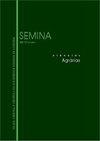Epidemiological situation of Equine Infectious Anemia in the state of Paraná, Brazil
IF 0.5
4区 农林科学
Q4 AGRICULTURE, MULTIDISCIPLINARY
引用次数: 0
Abstract
To assist decision making regarding the National Equine Health Program in the state of Paraná, a study was conducted to estimate the prevalence of infected farms and seropositive animals for Equine Infectious Anemia (EIA) and also identify possible risk factors for the disease. The state was divided into three regions, within which about 300 farms were randomly selected. On the selected farms, a minimum number of animals aged 6 months or older were examined to characterize them as infected or free of EIA. In the sampled farms, an epidemiological questionnaire was applied to investigate possible associations between the disease and its characteristics, including sanitary practices and livestock management. The test used was the Agar Gel Immunodiffusion Test. A total of 2818 equids from 889 farms were tested. In the state, the prevalence of infected farms was 1.55% [0.92; 3.00] and the prevalence of seropositive animals was 0.55% [0.27; 1.00]. Introduction of equids showed an association with EIA (OR=5.5 [1.9; 15.9]). Paraná equine owners should be alerted to the need to observe health precautions regarding EIA when introducing animals to their herd. In 2018, the sensitivity of the Surveillance System for EIA in Paraná was only 1.36%, probably insufficient to change the endemic balance of the disease, therefore, needs to be re-evaluated involving in the process all public and private agents interested in the subject.巴西帕拉纳州马传染性贫血的流行病学情况
为了协助制定有关帕拉纳州国家马健康计划的决策,进行了一项研究,以估计受感染农场和马传染性贫血(EIA)血清阳性动物的患病率,并确定该疾病的可能危险因素。该州被分为三个地区,其中随机选择了大约300个农场。在选定的农场,对至少6个月或以上的动物进行了检查,以确定它们是否感染或没有感染环境影响评估。在抽样的农场中,采用了流行病学调查表,以调查该病与其特征(包括卫生做法和牲畜管理)之间可能存在的联系。采用琼脂凝胶免疫扩散试验。来自889个农场的2818只马驹接受了测试。全州感染农场患病率为1.55% [0.92;3.00]血清阳性动物患病率为0.55% [0.27;1.00]。马科动物的引入与EIA相关(OR=5.5 [1.9;15.9])。偏旁马的主人在将动物引入他们的畜群时应注意观察有关环境影响评估的健康预防措施。2018年,该监测系统的敏感性仅为1.36%,可能不足以改变该疾病的流行平衡,因此,需要重新评估过程中所有感兴趣的公共和私人机构。
本文章由计算机程序翻译,如有差异,请以英文原文为准。
求助全文
约1分钟内获得全文
求助全文
来源期刊

Semina-ciencias Agrarias
农林科学-农业综合
CiteScore
1.10
自引率
0.00%
发文量
148
审稿时长
3-6 weeks
期刊介绍:
The Journal Semina Ciencias Agrarias (Semina: Cien. Agrar.) is a quarterly publication promoting Science and Technology and is associated with the State University of Londrina. It publishes original and review articles, as well as case reports and communications in the field of Agricultural Sciences, Animal Sciences, Food Sciences and Veterinary Medicine.
 求助内容:
求助内容: 应助结果提醒方式:
应助结果提醒方式:


